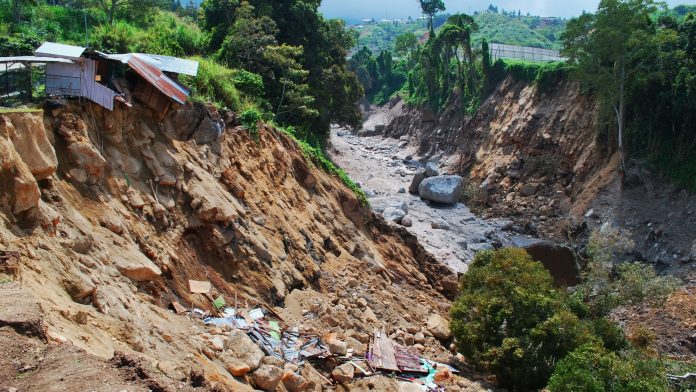Scientists at Graz University of Technology, Austria, have identified a series of chemical processes that could be the key to understanding landslides.
According to the World Health Organization, landslides cause over 18,000 death between 1998 and 2017. Globally, landslides and hill-slope debris flows cause billions of euros in economic damage every year. Between €20m and €80m is spent annually from Austria’s disaster fund to repair disaster damage, 15 to 50% of which is attributable to mud flows and landslides.
Study leader Andre Baldermann, from the Institute of Applied Geosciences at Graz University of Technology, based his results on recent investigations into repeated mass movements, such as landslides and hill-slope debris. This new study is expected to benefit the planning, maintenance, and development of transportation infrastructure in affected areas.
Baldermann’s team of earth scientists from Graz University of Technology has collaborated with the Burgenland state road administration to identify the chemical influencing factors and triggers for recurrent mass movements in fine-grained sediments. Using the researchers results published in the journal Science of the Total Environment, policy makers can implement preventive measures and strategies to guard against such events.
Factors contributing to landslides
The team based their study on a well-documented landslide in southern Burgenland, Austria. Through their analysis of terrain data, soil samples, drainage waters, and laboratory tests, it has been shown that the sensitivity of the subsurface to external influences is affected by natural (geogenic) chemical weathering processes that take place over millions of years and weaken the nature of the subsurface.
Anthropogenic chemical influencing factors also play a central role, such as agricultural activities, seeping road run-off or winter road maintenance. Volker Reinprecht, co-author and geologist, explains “In the study area, fine-grained sedimentary deposits dominate, as they are widespread in the basin areas in eastern Austria.”
“Heavy rain events and periods of dew, as well as continuous vibration from road traffic, have in the past caused the soil to literally ‘wash away’ and the affected road to require periodic rehabilitation.”
The role of soil drainage
The team discovered that the risk of landslides can be minimised by using an amended drainage system. The previous drainage system using transverse ribs, in which rainwater and seepage is captured in the area in contact with the sliding surface, was replaced by a longitudinal drainage system so that the water is removed from the subsoil within a few days and both backwater and chemical interaction processes are significantly reduced.
Baldermann explains: “Rapid drainage of the water reduces the soaking of the subsoil, reduces the formation of zones of weakness (sliding horizons) and thus increases the stability of the soil or the overall system.”
The team at Graz University of Technology have already demonstrated how the new drainage system can prevent mass movements. Baldermann explains: “We were able to demonstrate that backwater formation in the subsurface can activate the slip zones via chemical processes. This is prevented with longitudinal drainage elements and the resulting faster drainage. In future construction projects in zones at risk from sink holes, landslides or similar events, greater consideration should be given to possible interactions between the drainage system and the subsoil as early as the planning stage.”
Continued landslide research
The research team is planning on extending the study design to other affected regions with similar geological conditions. A view of the total system is important, as Baldermann explained: “The structure of the subsurface, as well as other region-specific factors, have a major influence on the nature, intensity, and periodicity of mass movements. The results and practical recommendations from the reference project are therefore not directly transferable one-to-one to other affected regions. But they are a first example of how to approach such problems in the future.”
About the Institute of Applied Geosciences
The Institute of Applied Geosciences educates undergraduate and graduate students for academia and industry leadership careers in environmental, hydrogeochemical, mineralogical and engineering (geo)sciences with focus on rock-mineral-water interface processes, and to advances the current state-of-knowledge through scholarly dissemination of original research that is relevant to the needs of the public and the society.








